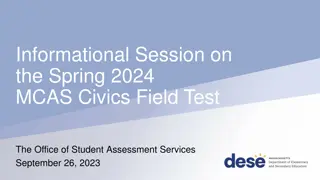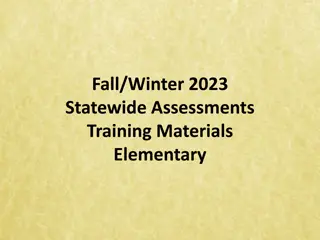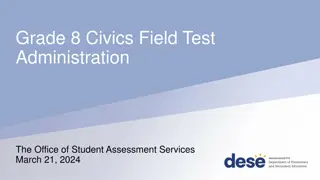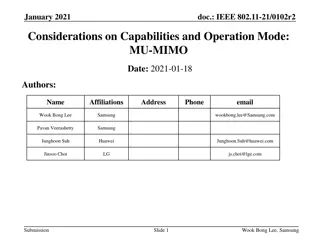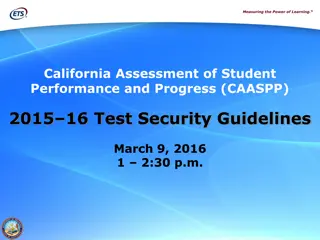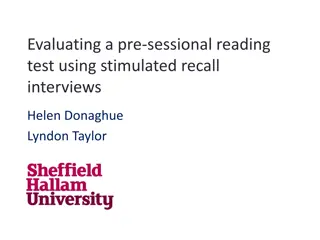
Insightful Quiz Questions on a Variety of Topics
Explore a series of thought-provoking quiz questions covering topics like ceremonial flags, classical republicanism, celestial events, leadership qualifications, naval operations, nutrition, forecasts for flight operations, and historical agreements. Test your knowledge and learn interesting facts along the way!
Download Presentation

Please find below an Image/Link to download the presentation.
The content on the website is provided AS IS for your information and personal use only. It may not be sold, licensed, or shared on other websites without obtaining consent from the author. If you encounter any issues during the download, it is possible that the publisher has removed the file from their server.
You are allowed to download the files provided on this website for personal or commercial use, subject to the condition that they are used lawfully. All files are the property of their respective owners.
The content on the website is provided AS IS for your information and personal use only. It may not be sold, licensed, or shared on other websites without obtaining consent from the author.
E N D
Presentation Transcript
1. a) A ceremonial flag What is the Guidon? b) A bearer c) An identification flag d) A topping ornament
2. According to the theory of classical republicanism, the best government directs its efforts toward the________instead of toward the interests of a select group. a) silent majority b) constituted authority c) common welfare d) private morality
3. Sometimes the Earth crosses a part of a former comet path. The tiny particles remaining from the comet then collide with our atmosphere, producing a a) meteoroid shower. b) gaseous tail. c) asteroid shower. d) meteor shower.
4. For a leader to be regarded as knowledgeable, what main qualifications are necessary? a) None of the answers are correct b) Significant job experience/Thorough job knowledge c) Schoolbook smarts/Significant job knowledge d) Thorough job knowledge/Schoolbook smarts
5. Nuclear-powered ships have a reactor department headed by a __________ officer whose job is the operation, care, and safety of the reactor plants and auxiliaries. a) Operations b) Reactor c) Engineering d) Combat systems
6. What are the largest of the Navy's communications facilities called? a) TADILs b) MUOS c) (OTH) R/T d) NavComSta
7. Natural chemical elements of the Earth used by the body to supply necessary nutrition are called what? a) Vitamins b) Proteins c) Minerals d) Carbohydrates
8. What types of forecasts are prepared for flight operations? a) Optimum Track Ship Route, and flight forecasts b) Flight, and terminal forecasts c) Route, and departing forecasts d) Route, flight and terminal forecasts
9. a) agree on territorial water trade. President Harding felt that the Allies should b) respect the U.S.'s knowledge of military affairs. c) come to an agreement on arms limitations. d) stay together on all issues of the war.
10. Runners who increase their carbohydrate intake and reduce exercise before a competition are doing what? a) Resting b) Carbo-energizing c) Hydrating d) Carbohydrate loading
11. What air-to-air missile was developed jointly by the United States and several North Atlantic Treaty Organization (NATO) nations as follow-on to the older medium-range Sparrow missile? a) Maverick b) AMRAAM c) Phoenix d) Sidewinder
12. Into which class of fire do flammable liquids such as oil, gasoline, cleaning agents, and paints belong? a) Class B b) Class C c) Class A d) Class D
13. Who signed the document for the United States accepting the surrender of Japan? a) President Truman b) Admiral Nimitz c) General MacArthur d) General Eisenhower
14. In his great adventure story, Moby Dick, Herman Melville wrote about the great New England industry of a) whaling, for lighting oil, whalebone, and other products. b) commercial fishing in the stormy waters along the East Coast. c) pirates and their hidden treasure. d) catching seals for their valuable fur.
15. When can cadets call a Training Time Out (TTO)? a) If they are feeling a sharp pain in their side b) If they feel like they are going to throw up c) All of the answers are correct d) If they fear for their personal safety
16. During Operation Desert Storm (1991) what aircraft took direct hits from missiles but was able to recover, undergo repairs, then fly missions again the next day? a) EA-6B Prowler b) F/A 18 Hornet c) F/A 18G Growler d) F-14 Tomcat
17. What watch is stationed on the fantail? a) Lifebuoy b) After lookout c) Lifeboat d) After steering
18. The first to seek new sea routes to the Indies and the Orient were the a) Portuguese. b) Spanish. c) Dutch. d) English.
19. The 40-inch "distance" in military drill refers to the a) length of the dress right, dress movement. b) space between your chest and the person to your front c) space measured between individuals from shoulder to shoulder, on the same line. d) length of the double time step.
20. What term is given to time-honored behaviors that have become common practice aboard Navy ships? a) Courtesies b) Ceremonies c) Customs d) Salutes
21. What operation was the first major attempt by the Allies to take home territory of an Axis nation? a) Operation Shingle b) Operation Overlord c) Operation Husky d) Operation Avalanche
22. What ribbon award is one of the more demanding of the NJROTC awards given to the cadet who qualifies in required overland navigation by compass and map? a) Orienteering Ribbon Award b) Participation Award c) Sea Cruise Award d) Physical Fitness Award
23. What is an unmanned, self-propelled vehicle containing a guidance system that is designed to fly and deliver an explosive payload to a target? a) Guided missile b) Smart bomb c) Rocket d) Projectile
24. Even though they did not support an established religion in America, the Founding Fathers were influenced by the ________heritage which they believed was a method of instilling virtue. a) Protestant b) Ancient Roman c) Roman Catholic d) Judeo-Christian
25. __________ buoys are similar to a bell buoy in shape but it has a series of gongs, each with a different tone, with hammers that are moved by the motion of the sea. a) Combination b) Whistle or horn c) Gong d) Lighted




